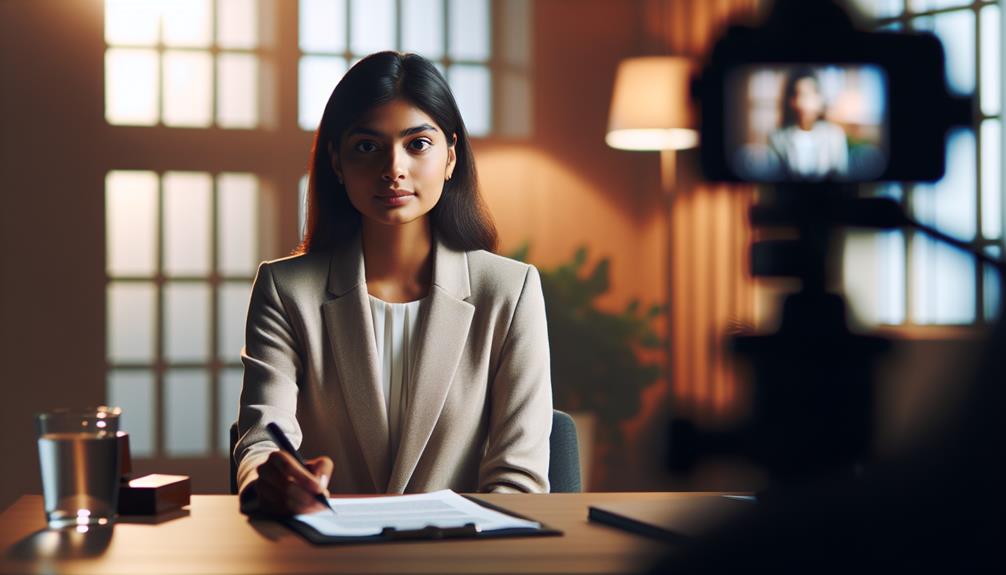When it comes to video depositions, preparation is everything. It's not just about knowing the facts or having a solid argument; it's about being able to present yourself in the best possible light.
And let's face it, the camera doesn't lie.
So, what techniques can you employ to ensure you come across as confident, composed, and compelling? Well, let's just say there are a few tricks up my sleeve that might surprise you.
Key Takeaways
- Dress and groom yourself in a conservative and tidy manner to project a professional image.
- Familiarize yourself with the audiovisual equipment used in video depositions and be prepared to troubleshoot any technical issues.
- Practice and refine your nonverbal communication skills, including maintaining eye contact and using appropriate gestures and posture.
- Establish an efficient system for organizing and presenting documents during the deposition to enhance effectiveness and clarity.
Dressing and Appearance

When preparing for a video deposition, it's crucial to consider the impact of dressing and appearance. Your attire and professional appearance can greatly influence how you're perceived by others, including the jury or judge. In today's digital age, where video depositions are becoming more common, it's important to understand the importance of presenting yourself in a professional manner.
First and foremost, it's essential to wear appropriate attire for a video deposition. This means dressing as you'd for an in-person deposition or court appearance. Choose clothing that's conservative, well-fitting, and free from distracting patterns or logos. Remember, you want the focus to be on your testimony, not your outfit.
Additionally, pay attention to your overall professional appearance. Make sure your hair is well-groomed and your grooming is tidy. Avoid excessive jewelry or accessories that may be distracting. Remember, the goal is to present yourself as a credible and reliable witness.
Familiarizing With the Technology
To effectively navigate a video deposition, it's crucial to familiarize oneself with the technology involved. This includes understanding the audiovisual equipment and being prepared to troubleshoot any technical issues that may arise.
In today's fast-paced world, innovation is key. The legal industry is no exception, and video depositions have become an increasingly popular method for capturing testimonies. By embracing this technology, we can streamline the legal process and ensure that justice is served efficiently.
When it comes to technical troubleshooting, it's essential to be proactive. Familiarize yourself with the audiovisual equipment that will be used during the deposition. Learn how to operate the cameras, microphones, and other devices to ensure a smooth recording. Additionally, make sure to test the equipment well in advance to identify and resolve any potential issues.
Practicing Body Language and Eye Contact

Now that we've become familiar with the technology involved in a video deposition, let's explore the importance of practicing body language and maintaining eye contact.
Nonverbal communication plays a crucial role in conveying our confidence and credibility during a video deposition. It's essential to practice and refine our body language skills to ensure we're presenting ourselves in the best possible light.
Practicing nonverbal communication involves being aware of our gestures, facial expressions, and posture. Simple things like sitting up straight, maintaining an open and relaxed posture, and using appropriate hand gestures can make a significant impact on how we're perceived by others.
Additionally, maintaining eye contact is crucial for establishing trust and engagement. It shows that we're actively listening and paying attention to the conversation at hand.
To maintain a confident demeanor, it's important to appear calm and composed. This can be achieved by regulating our breathing, controlling any nervous habits or fidgeting, and speaking with a clear and steady voice.
Confidence is contagious, and by practicing these techniques, we can inspire confidence in others as well.
Preparing and Organizing Documents
Preparing and organizing documents is a crucial step in ensuring a smooth and efficient video deposition process. Proper document management is essential for presenting evidence effectively and maximizing the impact of your case.
In today's digital age, traditional paper documents have been replaced by electronic files, which require a different approach to organization. To streamline the process, it's important to establish a clear system for categorizing and labeling documents. This will ensure quick and easy access to the relevant information during the deposition. Utilizing document management software can further enhance efficiency by allowing you to search, annotate, and share files seamlessly.
In addition to organizing the documents, it's essential to consider their presentation during the video deposition. Using technology to display documents on screen can help maintain focus and engagement. This can be done through video conferencing platforms or specialized document presentation software.
Properly preparing and organizing documents not only saves time but also enhances the overall effectiveness of a video deposition. It allows for a smoother flow of information, reduces the risk of overlooking crucial evidence, and ensures a more compelling presentation.
Anticipating and Preparing for Questions

As I anticipate the questions that may arise during the video deposition, I prepare myself by thoroughly reviewing the case facts and potential areas of inquiry. Effective communication and active listening are key in this process. By understanding the case inside out, I can confidently address any questions that come my way.
To effectively anticipate and prepare for questions, I first analyze the facts of the case. This involves going through all the relevant documents, witness statements, and any other evidence that may be presented. By doing so, I can gain a deep understanding of the case and identify potential areas of inquiry.
Active listening is crucial in preparing for questions. During the deposition, I need to pay close attention to the questions asked by opposing counsel, taking note of any key details or nuances. This allows me to respond in a clear and concise manner, ensuring that my answers are accurate and relevant.
Additionally, I make use of mock depositions to practice answering potential questions. This helps me refine my responses and build confidence in my ability to effectively communicate during the actual video deposition.
Conclusion
Preparing for a video deposition requires attention to detail and careful planning. From dressing professionally to familiarizing yourself with the technology, every aspect matters.
Practicing body language and maintaining eye contact can enhance your credibility. Additionally, organizing and preparing relevant documents is crucial for a smooth deposition.
Finally, anticipating and preparing for potential questions can help you respond confidently. By following these techniques, you can effectively navigate a video deposition and present your case with confidence.

